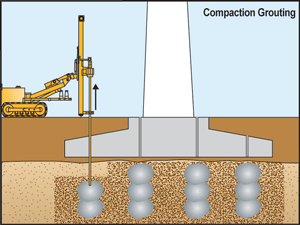Compaction grouting is a specialized geotechnical technique designed to improve soil strength and mitigate settlement issues in construction projects. It is widely used in areas with loose or unstable soils, providing a cost-effective solution to enhance the load-bearing capacity of the ground.
What is Compaction Grouting?
Compaction grouting involves injecting a low-mobility, high-density grout mixture into the ground under pressure. Unlike other grouting methods, the goal is not to fill voids but to displace and densify the surrounding soil. This process strengthens the soil matrix and reduces the risk of settlement.
How Does It Work?
1.Drilling Injection Points: A series of boreholes are drilled at strategic locations to access the targeted soil layers.
2.Grout Injection: A stiff grout mixture is pumped into the soil under controlled pressure.
3.Soil Displacement: The grout compacts the soil as it spreads, reducing voids and improving density.
4.Layered Compaction: The process is repeated in layers to achieve the desired level of soil stabilization.
Applications of Compaction Grouting
- Foundation Strengthening: Enhances the bearing capacity of soils for building foundations.
- Sinkhole Remediation: Fills voids and stabilizes soils in areas prone to sinkholes.
- Settlement Mitigation: Addresses uneven settling in structures such as roads, bridges, and buildings.
- Seismic Protection: Increases soil resistance to seismic activity, reducing liquefaction risks.
Benefits of Compaction Grouting
- Improved Soil Stability: Reinforces weak soils, ensuring long-term structural stability.
- Minimal Disruption: Can be performed with minimal surface disturbance, making it ideal for urban areas.
- Versatility: Applicable to a wide range of soil types and construction challenges.
- Cost-Effective: Reduces the need for more extensive and expensive soil stabilization methods.
Considerations and Limitations
While compaction grouting is highly effective, its success depends on proper planning and execution. Soil analysis, precise grout formulation, and careful monitoring of pressure and volume are critical to achieving the desired outcomes. Additionally, it may not be suitable for soils with high organic content or areas with shallow groundwater tables.
Conclusion
Compaction grouting is a reliable and adaptable solution for improving soil strength and addressing settlement issues. Its ability to enhance ground stability with minimal surface disruption makes it a preferred choice in many geotechnical engineering projects. With advancements in equipment and techniques, compaction grouting continues to play a vital role in ensuring safe and sustainable construction practices.







